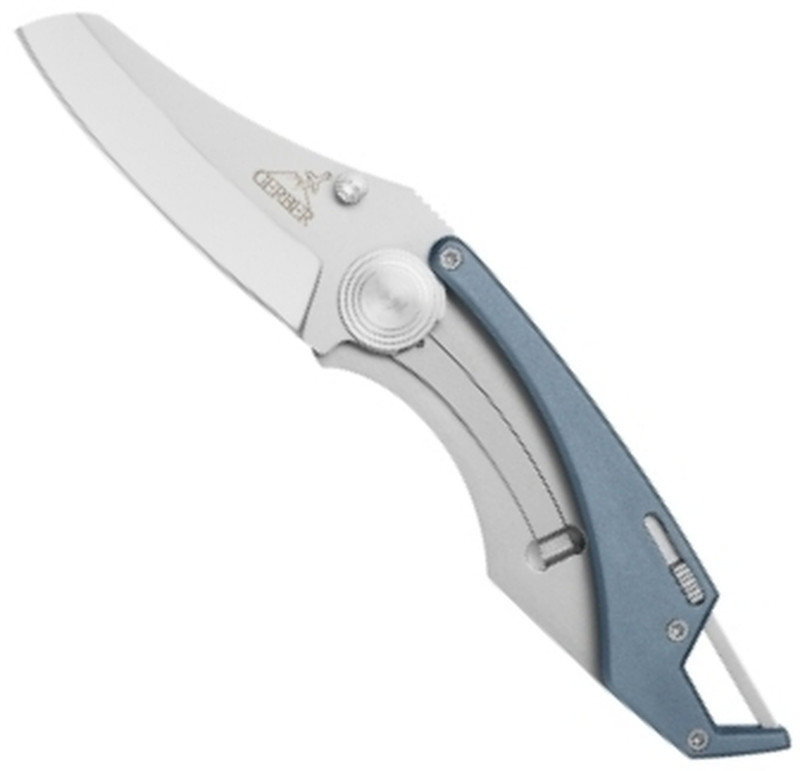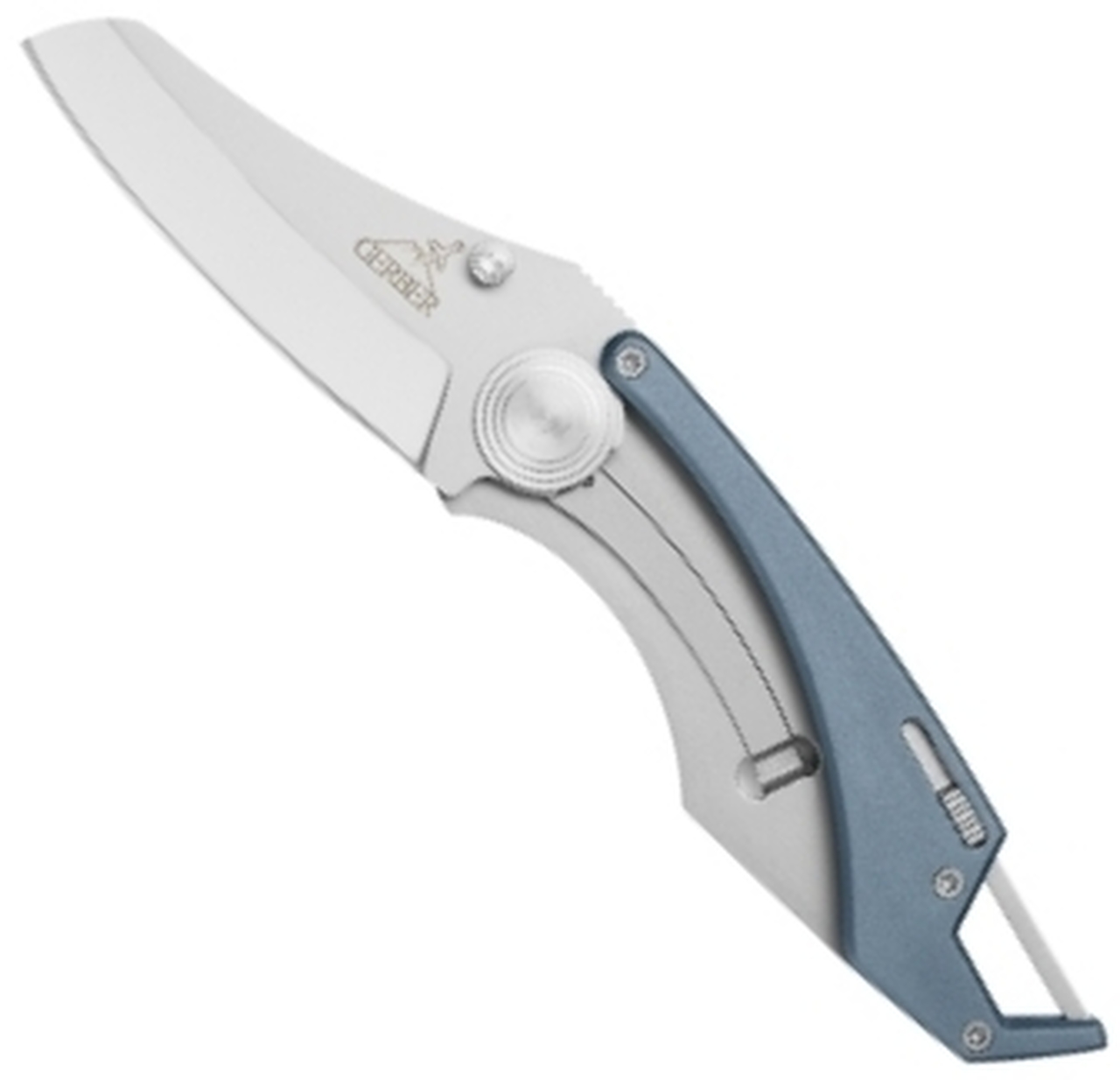Knife Review: The Gerber Descent Manual Folding Knife; Fine Edge
Posted by SD on Oct 14th 2019
The Gerber Descent Manual Folding Knife; Fine Edge
When Joseph R. Gerber described his young knife company, Gerber Legendary Blades, as the, “birth of an enterprise that grew into big business,” it was true, but it was an understatement for sure. What had started out in 1939 as a small batch of handmade cutlery sets given as holiday gifts had turned into thousands of retail accounts around the country. By 1960, Gerber had quickly become one of the most trusted, appreciated and collected names in knives.
Over 70 years since its founding and Gerber continues to grow. Still grounded in the same principles that first guided Joseph R. Gerber’s “enterprise,” Gerber is a company dedicated to making knives and tools that combine high quality materials and innovative designs that will stand up to a lifetime of use. The sleek, stainless steel sheath knives of the ’50s and ’60s (the Magnum Hunter) have given birth to today’s lightweight, open-frame clip folders (the Remix). Gerber is, however, no longer just a knife company. Multi-tools, axes, handsaws, machetes, headlamps, flashlights, survival kits, digging implements - these are the newest directions that Gerber explores with the same standards of quality and design that inform their revered knife making.
Gerber says, “Like the men and women who carry our gear, Gerber is Unstoppable. Decades of innovation and dedication have put us here. Renowned as a master of knives and tools, Gerber’s problem-solving, life-saving products are designed with the unique needs of specific activities in mind. Today that includes much more than a blade.
Founded in 1939 and based in Portland, Oregon, USA, Gerber is an American brand whose products have global reach and relevance. Carried extensively by hunters, soldiers and tradesmen, Gerber’s heritage runs deep. And we are now looking toward the future, where tomorrow’s problems will be solved by the next generation of innovations.
All Gerber products are designed and engineered in Portland, OR where many are produced. We also tap our global supply chain to create a wide range of activity specific gear for wide variety of consumers. And no matter what, every product that bears the Gerber name is backed by our famous lifetime warranty.
Quality, reliability, innovation. For over 70 years this is what our customers have expected from us. And whether our products are used to save time, save the day, or save a life, Gerber always delivers.”
Today we will be discussing the Gerber Descent Manual Folding Knife with a fine edge.
The Blade:
The blade on this is made out of a stainless steel. When it comes to knife blades, there is a huge list of different metals that can be used. However, all these metals (except for the rare exception) will fall into either a stainless steel or a high carbon classification.
Stainless steels usually have at least 12% chromium, which is going to do a few things for the steel. The first is a
positive: it makes it more resistant to rust and corrosion than a high carbon steel would be. However, it also is going to make it softer than a high carbon steel, which means that while it will be easier to sharpen, it is also going to lose its edge quicker than a high carbon steel.
Stainless steels are also usually tougher than a high carbon steel. This is good, but it does not mean that it is going to be harder. These two characteristics are commonly confused. Toughness and hardness are separate categories. In terms of durability, stainless steel blades do not rust, chip, or stain easily.
The next thing that is a benefit of a stainless steel is that they do not require any coating to keep its good looks and qualities. This is because of how rust resistant it is. Coatings are good, but they aren’t the best finish that you can come across. Since a stainless steel doesn’t need one, you’re going to find sleeker coatings that do not increase the overall cost of the knife as much.
Lastly, a stainless-steel blade has a great appearance for a very long time. This is due to all of the characteristics involved. This means that there is going to be less maintenance and it is going to look better in the long run than a high carbon steel would.
The blade has been finished satin. This is the most common blade finish that you are going to come across in the cutlery industry. This finish is popular because it looks nice, it is easy to do, and it doesn’t’ increase the overall cost of the blade too much. The satin finish is created when the manufacturer repeatedly sands the blade in one direction with an increasing level of a fine abrasive, which is normally a sandpaper.
This process is used to showcase the fine lines of the steel while also showing off the bevels of the blade. This creates a very traditional look that you aren’t going to find in another finish. It is classic without stealing the show.
This process also cuts down on glares and reflections, which is good in a tactical knife such as this one. You do not want the light reflecting harshly off the blade. It also helps to increase the corrosion resistance of the blade slightly. This is not going to increase it enough to make a huge difference, but the subtlety is there.
The blade has been carved into a very unique blade shape. The blade starts out by extending straight out of the handle. This portion is only about 1/8 of the overall blade. It is finished with a row of fine jimping, which will assist in giving you a little bit better control while you are working with the knife.
After this extension, it swoops down toward the nose of the blade. This blade actually does not have a tip, which means that the nose is slightly rounded. The benefit of not having a tip is that you are not going to accidentally pierce anything. This is a common feature on a lot of safety and rescue knives.
The descent does have a large belly, which is going to make slicing a lot easier. This is because it has more surface area, and the more surface area you have, the better you can slice. Like I said, there is not tip, so the sharpened edge ends where the nose cures down to meet it. The only disadvantage of not having a tip is that even if you did want to pierce something, you are not going to be able to.
The Handle:
The handle is made out of both stainless steel as well as aluminum. Aluminum itself is a widely popular option for high-quality knife handle materials. Aluminum is tough, durable, incredibly corrosion resistant, and best of all, it is lightweight. However, it is also prone to getting scratched.
Aluminum is known to be a low-density metal, which is where the low weight of the handle comes in from. A low-density metal is a metal that is going to provide you with the heft that you need to take on all of your tasks. It is not going to make you feel that you cannot rely on the handle—instead, it is going to give you enough heft in your hand that you feel confident. Confident enough to take on whatever comes your way. That being said, it is not going to weigh you down. This is a smaller knife, so any of the heft that you can get from the handle is going to be appreciated.
Aluminum has high conductive properties, so in colder environments, this knife may feel cold to the touch, which can hinder your use of this knife.
This aluminum on this handle has been anodized a metallic blue. This is a process that changes the make-up of the surface of the aluminum. It also enhances all of the good qualities that the aluminum already has, such as improving the strength and durability of this handle. It will also be more corrosion and wear resistant. Not only that, but it counteracts with some of the worse qualities that aluminum has. For example, it will not be as easy to scratch after it has been anodized.
The stainless-steel portion of the handle is going to add some serious heft and strength to this Gerber knife. Stainless steel is a great option for a knife handle, when it is not the entire knife handle, or when the knife is smaller. This is because stainless steel does add some serious weight to the knife. However, with a small knife such as the Descent, it is going to add in more heft, which will allow you to feel confident while using it.
Stainless steel is also rather corrosion and wear resistant, which will help to make this knife a lower maintenance knife. The stainless-steel portion of this handle is silver, which matches the blade perfectly. It will provide the handle with the same great benefits that stainless steel provides the blade with.
What is unique about this handle is that it is an open frame, which will make it easier to keep clean, dry, and lubricated. It also adds a unique characteristic that you really won’t see on many other knives. The aluminum portion of the handle is on the spine, and curves down so that near the butt, it is all aluminum. The aluminum is also a little bit more raised than the stainless-steel portion of the handle.
The Pocket Clip:
The Descent does have a low-rise pocket clip, which will ensure that the knife rides comfortably in your pocket. It also means that this small knife is going to be a little bit more concealed in your pocket. Plus, because it is sitting deeper in your pocket, it is going to be more secure as you move about your day.
Not only does it have a pocket clip, it also has a useful carabiner which slides back so you can clip the knife on a belt loop, a backpack, or a nylon cord.
The Mechanism:
This is a folding knife that uses a thumb stud to assist you in opening the knife. Folding knives are legal in more areas of the US because there is no mechanism that will swing it open. Manual knives are also a little easier to maintain than an automatic knife. However, fully manual knives are harder to bring into play than automatic knives, fixed blades, or even assisted opening knives.
The thumb stud is one of the most common opening mechanism because of how easy it is to use. You use your thumb to push against the stud, which will swing the knife open and lock it into place. The thumb stud also allows you to open the knife with just one hand, which is a major advantage on the Descent.
The Specs:
The blade on the Descent measures in at 2.6 inches, with a handle length, or closed length of 4 inches long. This means that when the knife is opened, it measures in at an overall length of 6.35 inches long, which is definitely on the smaller side. Due to the smallness of the frame as well as the lighter materials used, the Descent weighs in at 2.7 ounces.
Conclusion:
The Gerber Descent manual folder knife is a small knife packed with big features. This lightweight knife has a stainless steel and aluminum frame that is built open to make it easy to keep clean, dry and lubricated. The Descent has a low-rise pocket clip to ensure it rides in your pocket comfortable. It also has a very useful carabiner which slides back so you can clip the knife on a belt loop, a backpack or a nylon cord.
This knife is currently in stock at BladeOps. To order yours today, click here.


